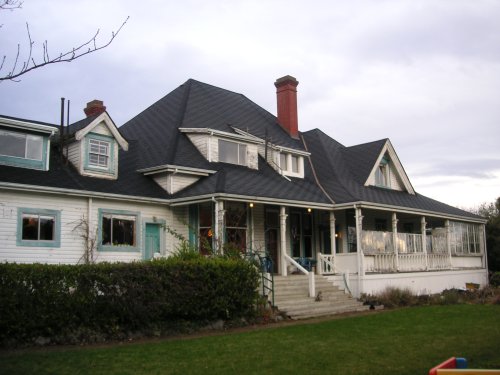1587-1595 York Place


‘Annandale’ is a large, one-and-one-half-storey wood clad bungalow with prominent brick corbelled chimneys, an enclosed porch, and multiple dormers; it is located on the east side of York Place, near the commercial centre of Oak Bay Avenue. It is set back on the property, screened by dense foliage and surrounded by a granite rubble-stone wall that has ‘Annandale’ carved in two sets of granite gate-piers.
‘Annandale’ is considered one of the most historically significant houses in Oak Bay for its connection with the Tupper family. It was built in 1897/8 by Sir Charles Hibbert Tupper, second son of Sir Charles Tupper (1821-1915), the last surviving Father of Confederation. Sir Charles Tupper was the Federal Minister for Railways and Canals in Sir John A. Macdonald’s Conservative government; an early supporter of the Canadian Pacific Railway, he helped to ensure the project’s completion. He became Prime Minister in May 1896; however, his defeat within three months, by Wilfred Laurier gave him the shortest prime-ministerial term in Canadian history. He was a frequent visitor to 'Annandale'. Sir Charles Hibbert Tupper (1856-1927) served as head of the Department of Marine and Fisheries in Sir John A. Macdonald's administration – at the time the youngest Canadian cabinet minister. He received a knighthood for his work on the Bering Sea sealing treaty (1893). The following year he became Minister of Justice in the government of Mackenzie Bowell, joining his father’s government as Solicitor General. In the late 1890s C.H. Tupper moved to BC with his family, and opened legal practices in Victoria and Vancouver. He settled in Vancouver and built a house called 'Parkside' (1899 – now demolished) in Vancouver’s West End to plans of Soule and Maclure. ‘Annandale’ appears to have been Tupper’s holiday home, and as such is a fine representation of a country estate, illustrating the lifestyle of prominent men and their families at the turn of the century.
‘Annandale’ was one of a pair of houses built in 1897-1898, the second residence being for the Honourable Frederick Peters, former Premier and Attorney-General of Prince Edward Island. Tupper and Peters were partners in a Victoria law firm established shortly after their arrival on the west coast. They stayed at the Hotel Mount Baker, and undoubtedly after conversations with architects F. M. Rattenbury and his partner, J. G. Tiarks, decided to build complementary homes on adjoining land just to the east of land owned by Rattenbury and Tiarks. In 1898 architects J. G. Tiarks and F. M. Rattenbury, recognizing the potential value of the Oak Bay waterfront, purchased land extending from Oak Bay Avenue eastward to present-day San Carlos Avenue. The whole parcel of land was acquired from the estate of the late Joseph Despard Pemberton, former Surveyor General of the colony of Vancouver Island. Over the next few years the partners began development in the area and influenced construction of quality homes on adjacent land. The 'Annandale' estate originally had a carriage house with a turning circle, the house and part of the circle survive, but are no longer part of the property.
The heritage value of ‘Annandale’ is associated with its architect, John Gerhard Tiarks (1867-1901). Good family and social connections, as well as design skill contributed to Tiarks’ success. He achieved much in his short life, erecting over seventy-five buildings during a thirteen-year period. Trained in England, he arrived in British Columbia during the economic boom following the arrival of the trans-continental railway. He quickly became a force in local architectural circles, primarily for his residential designs for the social élite – one of his designs was published in the Canadian Architect & Builder; and he served as an officer of British Columbia Institute of Architects. His ambition is exemplified by his double competition entries for the new Parliament Buildings in 1892. Tiarks eschewed elaborate Victorian details, hallmarks of his style being shallow Tudor arches, cedar panelling, broad verandahs and the application of vertical boards on drop siding – all of which are in evidence in 'Annandale'
‘Annandale’ is of heritage significance for the survival of much of its interior fabric, including woodwork and fittings. The high quality and fine workmanship of the interior provides a valuable illustration of the taste and expectations of professionals such as Sir Charles Hibbert Tupper.
- view to ocean and Mount Baker
- setback from the street, in keeping with the streetscape
- form, scale and massing
- steeply-pitched hipped roof with gables and dormers
- wood frame construction including bevelled drop siding, corner boards, vertical boards over drop siding; heavy moulding
- style details such as: picturesque silhouette; prominent corbelled brick chimneys, deep eaves, box bay windows
- exterior architectural elements such as: broad verandah with removable glazed sashes, turned balusters, and applied moulding; window horns; pedimented window frames; glazed front door with transom and sidelights
- fenestration, and window types such as: box, and angled bays; double-hung wood sashes; casements
- original interior features such as: woodwork; Tudor arches; window embrasures; fireplaces; door furniture; tiles
- landscape features such as: granite stone wall with two entrances flanked by granite piers with ‘Annandale’ incised in the caps and protective plinth blocks, with original cast iron gates, part of carriage turning circle
 Instagram
Instagram
 Facebook
Facebook
 Twitter
Follow @DistrictOakBay
Twitter
Follow @DistrictOakBay